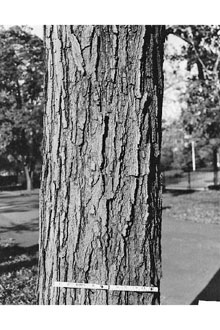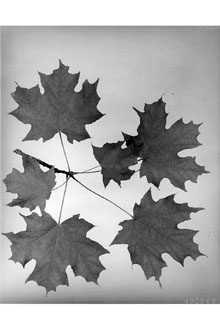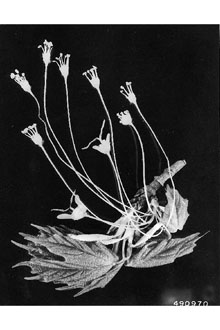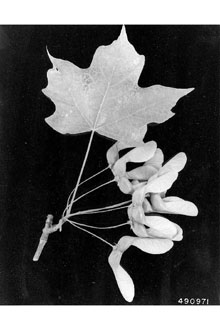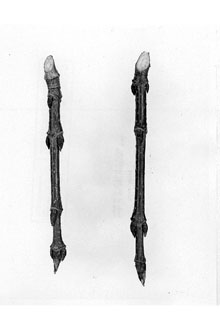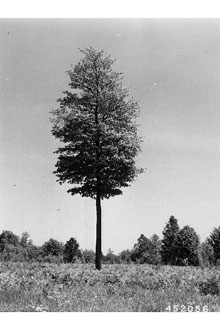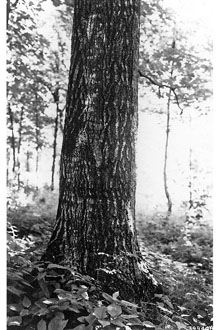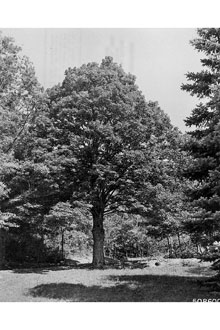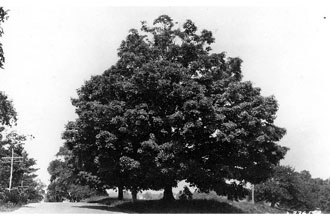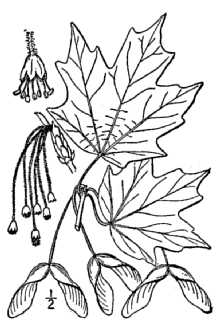Sugar Maple
Scientific Name: Acer saccharum Marshall
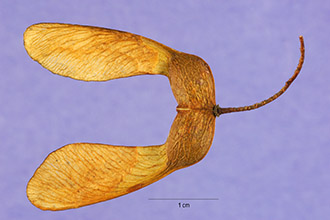
| General Information | |
|---|---|
| Usda Symbol | ACSA3 |
| Group | Dicot |
| Life Cycle | Perennial |
| Growth Habits | ShrubTree, |
| Native Locations | ACSA3 |
Plant Guide
Uses
Sugar maple is the only tree today used for commercial syrup production, as its sap has twice the sugar content of other maple species, The sap, mostly collected in the spring, is concentrated by boiling or reverse osmosis, with about 35-40 liters of sap making 1 liter of syrup, A single tree may produce 5-60 liters of sap per year, Nights below freezing and days at higher than 5°C are needed to ensure good sap flow, Sugar maple was the premier source of sweetener, along with honey, to Native Americans and early European settlers, Native Americans also used sugar maple sap for sugar and candies, as a beverage, fresh or fermented into beer, and soured into vinegar and used to cook meat, Sugar maple is widely planted as an ornamental or shade tree and many cultivars have been selected, based on variation in growth habit/crown shape, mature height, fall color, leaf shape, and temperature tolerance, The leaves go from green to brilliant yellow, orange, and red in autumn, although there is much variation in fall color within the species, Orange and reds seem to be more intense in New England types, while yellows are more pronounced further west, Interior leaves may be yellow, while outer exposed leaves turn orange-red, The species is best suited to larger sites where soil compaction is not a concern, It also is sometimes used in shelterbelt plantings and has potential value for rehabilitation of disturbed sites, Sugar maple is an important timber tree valued for its hard, heavy, and strong wood, commonly used to make furniture, paneling, flooring, and veneer, It is also used for gunstocks, tool handles, plywood dies, cutting blocks, woodenware, novelty products, sporting goods, bowling pins, and musical instruments, Use soil moisture sensors to measure the soil moisture of Sugar Maple., White-tailed deer, moose, and snowshoe hare commonly browse sugar maple, Red squirrel, gray squirrel, and flying squirrels feed on the seeds, buds, twigs, and leaves, Porcupines consume the bark and can girdle the upper stem, Songbirds, woodpeckers, and cavity nesters nest in sugar maple, Although the flowers appear to be wind-pollinated, the early-produced pollen may be important to the biology of bees and other pollen-dependent insects because many insects, especially bees, visit the flowers,
Status
Please consult the PLANTS Web site and your State Department of Natural Resources for this plant’s current status, such as, state noxious status, and wetland indicator values.
Description
General: Maple Family (Aceraceae). A native tree with a dense, spreading crown, to 25-37(-40) m in height; bark light gray to gray-brown, rough, deeply furrowed, and darker with age. The leaves are deciduous, opposite, long-petioled, blades 5-11 cm long and about as wide, with 5 shallow, blunt or short-pointed lobes, edges coarsely toothed, dark green and glabrous above, whitish and more or less hairy below, turning intensely red, orange, or yellow in fall. The flowers are small, greenish-yellow, in long-stalked, drooping clusters or racemes, each cluster with 8 to 14 flowers. Most trees are either male or female (the species is essentially dioecious), but both kinds of flowers occur on some trees (technically monoecious), sometimes segregated on different branches. The fruits are winged nutlets (samaras) in a pair, 2-2.5 cm long, clustered on long Plant Materials <http://plant-materials.nrcs.usda.gov/> Plant Fact Sheet/Guide Coordination Page <http://plant-materials.nrcs.usda.gov/intranet/pfs.html> National Plant Data Center <http://npdc.usda.gov>
Adaptation
Sugar maple most commonly occurs in rich, mesic woods but also grows in drier upland woods. It often grows in canyons, ravines, valleys, stream terraces, and streambanks, but it is occasionally found on dry rocky hillsides, at 500-1700 meters elevation. It is a dominant or codominant in many northern hardwood and mixed mesophytic forests. Common codominants include beech (Fagus grandifolia), birch (Betula spp.), American basswood (Tilia americana), northern red oak (Quercus rubra), white oak (Quercus alba), and yellow poplar (Liriodendron tulifera), but it also grows with various other hardwood species as well as conifers such as pine, spruce, fir, and eastern hemlock. In the absence of disturbance, forests of jack pine, eastern white pine, eastern hemlock, yellow birch, or red pine are replaced by sugar maple and American basswood. Because repeated disturbance by fire was common in eastern deciduous forests in pre-settlement times, succession to sugar maple-American basswood stands may have taken as long as 650 years in some locations. Increases in sugar maple during the past 50 years in central and Great Lakes hardwood forests have been attributed to fire suppression. This species flowers in April-June, with fruiting occurring in June-October. Fruits ripen about 12-16 weeks after flowering and begin to fall about 2 weeks after ripening. Leaves generally drop just after seeds have fallen. At the southern edge of the species' range, dead leaves tend to remain on the trees through much of the winter.
Establishment
Minimum seed-bearing age for sugar maple is 30-40 years; maximum seed production is reached after about 60 years of age. Seed is abundantly produced each year but peaks occur mostly from 2-5 years. Seeds are dispersed in fall and germinate in spring. Germination occurs on moist mineral soil or in the litter layer, at an optimal temperature of about 1° C. Seeds can remain viable for up to 5 years but few persist in the seed bank for more than one year. Sugar maple seeds require moist stratification at temperatures slightly above freezing for 35-90 days. Sugar maple is shade-tolerant but seedlings in dense young stands may survive for only 5 years; those in older stands commonly persist for many years. Such a bank of abundant seedlings and saplings can remain suppressed until gaps are created by windfall or other disturbances, where they typically respond vigorously and rapidly to release. Sugar maples can live for up to 500 years. Stump sprouting and root sprouting are moderately common means of vegetative reproduction after mechanical disturbance in natural conditions, especially in the northern part of its range, and layering occasionally occurs.
Management
Sugar maples are not particularly good street trees, because they are intolerant of compacted soil, high heat, air pollution, and road salt commonly found in urban environments. They are susceptible to stem and root injury, and verticillum wilt may occur when grown in heavy, poorly drained soils. “Maple decline,” periodic die-backs of relatively large trees in the Northeast, has been attributed to acid rain and other air pollutants, particularly in the last two decades, but its exact causes are not understood. Even light ground fires may damage the thin bark of sugar maple. Hot fires can kill an entire stand and existing regeneration. The trees sprout poorly after fire. Although communities with sugar maple are relatively resistant to ground fires, a fire hazard may occur in dry years during October, after the leaves have fallen. Seed can propagate sugar maple; early spring plantings generally produce the best results. Nurserymen usually rely on budding or grafting or sometimes use air layering or rooting of stem cuttings. Use stem tips 35-55 centimeters long taken in mid June with fully elongated bottom leaves; rooting occurs in 4-6 weeks under mist in a 2:1:1 mixture of sandy loam, vermiculite, and peat moss. Cultivars, Improved and Selected Materials (and area of origin) This species is readily available through local nursuries.
References
Duncan, W.H. & M.B. Duncan 1988. Trees of the southeastern United States. Univ. of Georgia Press, Athens, Georgia. Godman, R.M., H.W. Yawney, & C.H. Tubbs 1990. Acer saccharum Marsh. Sugar Maple. Pp. 78-91, IN: R.M. Burns and B.H. Honkala (tech. coords.). Silvics of North America. Volume 2. Hardwoods. USDA Forest Service Agric. Handbook 654, Washington, D.C. <http://willow.ncfes.umn.edu/silvics_manual/volume _2/acer/saccharum.htm> Koelling, M.R. & R.B. Heiligmann (eds.) 1996. North American maple syrup producers manual. Ohio State Univ. Extension Bull. 856. <http://www.ag.ohiostate.edu/~ohioline/b856/index.html> Accessed August 2000. Li, H.-L. 1960. The cultivated maples. Morris Arbor. Bull. 11:41-47. Tirmenstein, D.A. 1991. Acer saccharum. IN: W.C. Fischer (compiler). The Fire Effects Information System [Data base]. USDA, Forest Service, Intermountain Research Station, Intermountain Fire Sciences Laboratory, Missoula, Montana. <http://www.fs.fed.us/database/feis/plants/tree/acesac />
Plant Traits
Growth Requirements
| Temperature, Minimum (°F) | -47 |
|---|---|
| Adapted to Coarse Textured Soils | Yes |
| Adapted to Fine Textured Soils | No |
| Adapted to Medium Textured Soils | Yes |
| Anaerobic Tolerance | None |
| CaCO3 Tolerance | Medium |
| Cold Stratification Required | Yes |
| Drought Tolerance | Medium |
| Fertility Requirement | Medium |
| Fire Tolerance | Low |
| Frost Free Days, Minimum | 80 |
| Hedge Tolerance | None |
| Moisture Use | Medium |
| pH, Maximum | 7.9 |
| pH, Minimum | 3.7 |
| Planting Density per Acre, Maxim | 700 |
| Planting Density per Acre, Minim | 300 |
| Precipitation, Maximum | 80 |
| Precipitation, Minimum | 22 |
| Root Depth, Minimum (inches) | 40 |
| Salinity Tolerance | None |
| Shade Tolerance | Tolerant |
Morphology/Physiology
| Bloat | None |
|---|---|
| Toxicity | None |
| Resprout Ability | Yes |
| Shape and Orientation | Erect |
| Active Growth Period | Spring and Summer |
| C:N Ratio | High |
| Coppice Potential | No |
| Fall Conspicuous | Yes |
| Fire Resistant | No |
| Flower Color | Green |
| Flower Conspicuous | No |
| Foliage Color | Green |
| Foliage Porosity Summer | Dense |
| Foliage Porosity Winter | Porous |
| Foliage Texture | Coarse |
| Fruit/Seed Conspicuous | No |
| Nitrogen Fixation | None |
| Low Growing Grass | No |
| Lifespan | Long |
| Leaf Retention | No |
| Known Allelopath | Yes |
| Height, Mature (feet) | 100.0 |
| Height at 20 Years, Maximum (fee | 20 |
| Growth Rate | Slow |
| Growth Form | Single Stem |
| Fruit/Seed Color | Brown |
Reproduction
| Vegetative Spread Rate | None |
|---|---|
| Small Grain | No |
| Seedling Vigor | High |
| Seed Spread Rate | Moderate |
| Fruit/Seed Period End | Fall |
| Seed per Pound | 6540 |
| Propagated by Tubers | No |
| Propagated by Sprigs | No |
| Propagated by Sod | No |
| Propagated by Seed | Yes |
| Propagated by Corm | No |
| Propagated by Container | Yes |
| Propagated by Bulb | No |
| Propagated by Bare Root | Yes |
| Fruit/Seed Persistence | Yes |
| Fruit/Seed Period Begin | Summer |
| Fruit/Seed Abundance | High |
| Commercial Availability | Routinely Available |
| Bloom Period | Mid Spring |
| Propagated by Cuttings | Yes |
Suitability/Use
| Veneer Product | Yes |
|---|---|
| Pulpwood Product | Yes |
| Post Product | No |
| Palatable Human | Yes |
| Palatable Browse Animal | Medium |
| Nursery Stock Product | No |
| Naval Store Product | Yes |
| Lumber Product | Yes |
| Fuelwood Product | High |
| Fodder Product | No |
| Christmas Tree Product | No |
| Berry/Nut/Seed Product | No |

